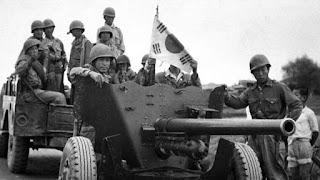South Korean War and North Korea 1950
On June 25, 1950, North Korea invaded South Korea
and the real war began. North Korea, supported by the Soviet Union and China,
came across the 38th Parallel and fought with South Korean troops. In response,
the UN Security Council provided assistance to South Korea and immediately
began sending troops. In total, 21 countries contribute to UN forces, but the
main support comes from the United States, which provides about 90% of military
personnel.
Initially, this war was a defensive war for the
United States and the Allies to drive communists out of South Korea, but the
North Korean army was well disciplined, trained and equipped with good weapons.
Meanwhile South Korea's strength, on the other hand, is frightened, confused
and tends to want to escape from the battlefield. Moreover, it was one of the
worst summers and the United States army was forced to drink water from rice
fields that had been contaminated with human waste so that diseases emerged
that infected the soldiers. This is certainly a big loss for the United States
and the Allies.
The Soviet Union supported North Korea at the start
of the war, giving it weapons, tanks and strategic advice. However, China
emerged as a substitute for its most important ally, sending troops to fight in
Korea as a way to keep conflict away from its borders and also as a way for the
then Chinese leader, Mao Zedong, to thank Korean Communists who fought in the
previous Chinese civil war.
Technically, the Korean War never ends. However,
fighting stopped when North Korea, China and the United States reached a
ceasefire in 1953.
In July 1951, North and South began peace talks in
Panmunjom, a village located almost exactly on the 38th Parallel. Over the next
two years, negotiations stopped, fighting continued along the new front lines
in the 38th Parallel, bombing campaigns took place, fighter jets engaged in
air-to-air battles for the first time in history and still no party managed to
make a peace agreement.
Finally, after more than two years of negotiations,
the North agreed to sign a truce on July 27, 1953. The agreement allowed
prisoners of war to remain in their preferred place (between North and South
Korea), drawing new boundaries near the 38th Parallel which gave South Korea an
area of more than 1,500 square miles and created a "demilitarized
zone" of 2 miles that still exists today.
South Korea does not approve the truce. This
agreement was only signed by the United States, UN representatives, North Korea
and China, because the South Koreans believe that they must continue to
increase the number of troops to march along the road to the Yalu River and
unite Korea completely. Although the ceasefire has lasted a long time, no
official peace agreement has ever been signed, so the war technically continues
to this day.










Komentar
Posting Komentar